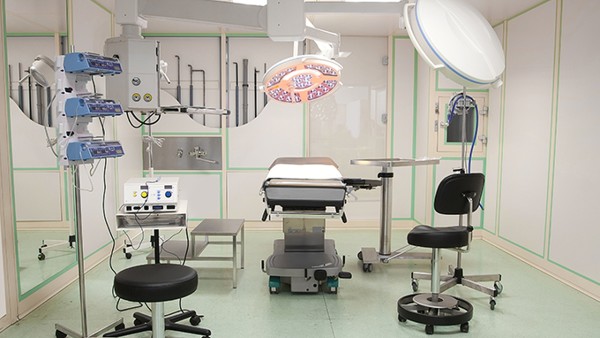10 Major Details of Caesarean Section Surgery

What is a Caesarean Section (C-Section)?
A caesarean section, also known as a C-section, is a surgical procedure used to deliver a baby when vaginal delivery is not possible or advised. It involves making an incision in the abdomen and uterus to remove the baby. C-sections are typically performed when there is a medical reason, such as:
Placenta previa: When the placenta covers the cervix, creating a barrier to vaginal delivery.
Breech presentation: When the baby is in a breech position (feet or buttocks first).
Cord prolapse: When the umbilical cord descends ahead of the baby during labor.
Fetal distress: When the baby is not getting enough oxygen or nutrients.
Maternal health concerns: Such as preeclampsia, gestational diabetes, or infections that could affect the baby's safety.
Preoperative Preparation
Before surgery, you will need to undergo a preoperative assessment to ensure you are fit for the procedure. This may include:
Medical history review: Discussion of any medical conditions, medications, or allergies.
Physical examination: To assess your overall health and determine the best surgical approach.
Blood tests: To check for anemia, infection, or other potential issues.
Ultrasound: To confirm the baby's position and assess the placenta's location.
Informed consent: Providing detailed information about the surgery and obtaining your consent.
Surgical Procedure
The surgery is typically performed under regional anesthesia, which numbs the lower body while you remain conscious. In some cases, general anesthesia may be necessary. The procedure involves the following steps:
Abdominal incision: A horizontal incision is made in the lower abdomen, just above the pubic bone.
Uterine incision: A vertical incision is made in the uterus.
Cesarean delivery: The baby is gently lifted out of the uterus.
Placental removal: The placenta is detached from the uterus and removed.
Uterine closure: The uterine incision is sutured closed.
Abdominal closure: The abdominal incision is closed with sutures or staples.
Postoperative Care
After surgery, you will be monitored closely in the recovery room. Pain medication will be administered to relieve discomfort. You will likely need to stay in the hospital for 2-3 days. During this time, you will:
Rest: Avoid strenuous activity and rest as much as possible.
Incision care: Keep the incision clean and dry. Change the dressing as directed.
Pain management: Take pain medication as prescribed.
Vaginal bleeding: You may experience vaginal bleeding for a few weeks after surgery.
Bowel movements: Avoid straining during bowel movements. Use stool softeners or laxatives if needed.
Bathing: You can usually shower 24 hours after surgery.
Follow-up care: You will have a follow-up appointment with your doctor 6-8 weeks after surgery to check on your recovery.
Recovery and Healing
Healing from a C-section typically takes 4-6 weeks. During this time, it is important to:
Get adequate rest: Sleep as much as possible and avoid overexertion.
Avoid heavy lifting: Do not lift anything heavier than 10 pounds for the first few weeks.
Maintain good hygiene: Keep the incision clean and dry to prevent infection.
Follow dietary recommendations: Eat a healthy diet and drink plenty of fluids.
Seek medical attention: Contact your doctor if you experience any signs of infection, excessive bleeding, or persistent pain.
Risks and Complications
Like any surgical procedure, a C-section carries certain risks and complications. These include:
Bleeding: Excessive bleeding during or after surgery.
Infection: Infection in the incision or uterus.
Blood clots: Clots may form in the legs or lungs.
Injury to the baby: The baby may sustain injuries during the delivery.
Future pregnancy complications: Women who have had a C-section may have an increased risk of complications in subsequent pregnancies.
Scarring: The abdominal incision will heal into a scar.
Planning for a C-Section
If you are planning for a C-section, it is important to:
Discuss your concerns: Talk to your doctor about any fears or concerns you have regarding the surgery.
Prepare for recovery: Make arrangements for help with childcare, housework, and errands.
Learn about pain management options: Ask your doctor about the different pain relief methods available.
Follow your doctor's instructions: Adhere to the instructions provided by your doctor before and after surgery to ensure a smooth recovery.
Conclusion
A C-section is a major surgical procedure but can be essential for a safe and healthy delivery. With proper planning and care, you can increase the chances of a successful recovery and a healthy baby.
The above is all the content that the editor wants to share with you. I sincerely hope that these contents can bring some help to your life and health, and I also wish that your life will be happier and happier.
Topic: #details #major #of- • Principles and five details of caring for newborn umbilical cord
- • 8 details to pay attention to when preparing for pregnancy
- • Pay attention to these 3 details to prevent children from being burned
- • Pay attention to the details of your health care routine to help you recover fas
- • 5 details not to be missed after caesarean section















